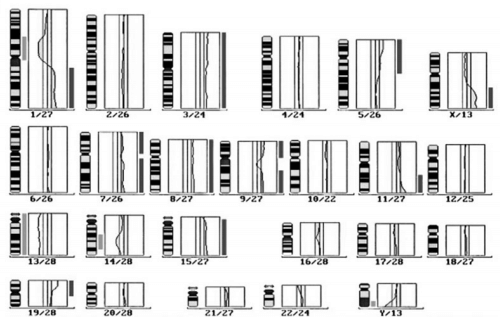Comparative Genomic Hybridization (CGH)
CGH is a technology that can detect changes in chromosome copy numbers without cell culture. Simultaneous hybridization of differentially labeled test DNA and normal reference DNA with normal metaphase chromosomes can provide a global overview of chromosome gains and losses in the entire genome. The hybridized DNA labeled with two different fluorescent dyes is captured by a fluorescence microscope. The difference between the probe's test and reference DNA binding on the target metaphase chromosome reflects the copy number difference between the test and reference genomes at each chromosome position. The region where the DNA sequence (deletion, duplication, or amplification) is lost or gained is shown as the relative change in the fluorescence intensity of the two samples along with the target chromosome.
CGH is one of the most widely used methods to detect the amplification and large-scale acquisition or loss of genetic material because it can achieve a genome-wide screening imbalance in a single experiment. Chromosomal CGH (cCGH) involves a competitive hybridization with the same amount of differential marker test and reference whole genome DNA with the normal metaphase. In addition, the comparative genomic hybridization technology based on microdissection (micro-CGH) has gradually developed and is applied to the cytogenetic analysis of solid tumors.
 Fig 1. A case of chromosome analysis based on micro-CGH. (Liehr T, et al. 2017)
Fig 1. A case of chromosome analysis based on micro-CGH. (Liehr T, et al. 2017)
Classic CGH scheme and micro-CGH analysis
CGH analysis by FISH is a classic method for detecting staining variation. Our platform provides usable CGH analysis solutions for solid tumor cytogenetics research. Our platform provides traditional CGH analysis and optional micro-CGH analysis. The basic process of traditional CGH analysis includes sample preparation, probe preparation, FISH hybridization, Chromomycin A3 staining (CMA3), imaging, and data analysis. Usually, the obtained data memory is further analyzed through the External Profiles Function and Warp Tool software ("sequence band" analysis). Through the simultaneous application of cCGH and sequence bands and subsequent analysis using the Warp tool, the resolution of cCGH is greatly improved (<2 Mb). The results obtained from the test provide a direct and more precise allocation of gains, amplifications, and losses to genomic regions. In addition, we provide independent micro-CGH services, and we have independent experiments to complete chromosome microdissections. This service can be used for cytogenetic analysis of solid tumor samples. Please consult our experts for specific information.
 Fig 2. CGH analysis and service features.
Fig 2. CGH analysis and service features.
Technology Features
CGH can be applied to a variety of samples with genomic DNA, and can quickly and effectively analyze a large number of samples.
The routine use of CGH in the analysis program of paraffin-embedded tissue allows it to conduct research on old archive samples.
CGH can examine very small samples after DNA amplification based on polymerase chain reaction (PCR), such as a few cells microdissected from a specific part of a tumor.
CGH can detect changes in the copy number of DNA sequences in the entire genome in one hybridization, and map these sometimes very complex changes to normal metaphase chromosomes.
Creative Bioarray provides classic CGH services for cytogenetic analysis, such as chromosome copy number measurement and chromosome structural variation. This technology allows research on archived samples and has a cost advantage. If you are interested in our CGH service, please contact us for cooperation. We look forward to cooperating with you in the near future.
References
- Liehr T, Glaser A, Kosyakova N. Comparative Genomic Hybridization (CGH) and Microdissection-Based CGH (Micro-CGH)[M]//Fluorescence In Situ Hybridization (FISH). Springer, Berlin, Heidelberg, 2017: 561-565.
- Kowalska A, Bozsaky E, Ambros P F. Sequence-based high resolution chromosomal comparative genomic hybridization (CGH)[M]//Fluorescence in situ Hybridization (FISH). Humana Press, Totowa, NJ, 2010: 299-312.


 Fig 1. A case of chromosome analysis based on micro-CGH. (Liehr T, et al. 2017)
Fig 1. A case of chromosome analysis based on micro-CGH. (Liehr T, et al. 2017) Fig 2. CGH analysis and service features.
Fig 2. CGH analysis and service features.


